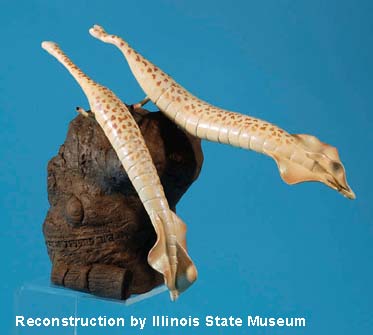State Symbol: Illinois State Fossil — Tully Monster (Tullimonstrum gregarium)

The Tully Monster was a soft-bodied animal. It is preserved as outlines and flattened forms in nodules of ironstone from several areas in Illinois. It lived in the ocean that covered much of Illinois during the Pennsylvanian Period (about 300 million years ago). It was probably an active, swimming carnivore. The flexible body was probably round or oval in cross section. It may have been segmented, but some recent work suggests that it was not. The tail had horizontal fins and a dorsal fin; all three of the fins were triangular.
The Tully Monster had a long proboscis. At the end was a “jaw” that contained eight small, sharp teeth. There is no evidence that the throat went down the proboscis. It seems more likely that the proboscis was a muscular organ used to pass food to the mouth. Near the middle of the body was a transverse bar that passed through the body. The bar had swellings on the end. These may have been the animal’s sensory organs. Scientists do not know to what other animals the Tully Monster is related. Some scientists have speculated that it is related to snails and other molluscs.
The Tully Monster was first found by Mr. Francis Tully in 1958. He took the specimens to the Field Museum of Natural History in Chicago. The specimen defied identification and became known as the “Tully Monster.” The name stuck. When Dr. Eugene Richardson formally described the new animal, he gave it the name Tullimonstrum gregarium. The species name gregarium means common. This refers to the fact that Tully Monsters are fairly common fossils in the Mazon Creek deposits. More recently they have also been found in open-pit coal mines in central Illinois.
The Mazon Creek deposits are located in Will and Grundy Counties. They are some of the most important fossil deposits in North America because the soft parts of many organisms are preserved. The deposits contain the remains of both plants and animals. Some of the organisms lived in the ocean; others were washed in from the nearby shore. The material is preserved in concretions of ironstone.
The Symbol:
The Tully Monster was designated as the State Fossil in 1989. Check out the Tully Monster donated to the Illinois State Museum, and link to Mazon Creek Fossils here.
References:
R. L. Leary, 1987, "The Tully Monster: mystery animal of Illinois", The Living Museum, 49: 26-27. M. H. Nitecki (editor), 1979, Mazon Creek Fossils, New York: Academic Press, Inc. 581pp.
I. Thompson, 1978, The Audubon Society Guide to North American Fossils, New York: Alfred A.. Knopf, Inc., 846pp.
https://www.isgs.uiuc.edu/fossils/mainpage.htm Fossils of Illinois Page of the Illinois Geological Survey.